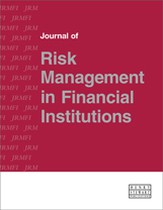A test of the feasibility of a common risk accounting metric for enterprise risks
Abstract
The risk accounting technique proposed by Grody and Hughes introduces a common enterprise risk measurement framework and a new risk metric — the risk unit (RU) — to express all forms of enterprise risk. The method’s creators contend that the application of an additive, common risk metric enables the consistent and comparable calculation and reporting of exposure to enterprise risks. The method’s alignment with accounting systems provides a single source of risk data derived from official accounting records and a common framework for the control and reporting of both financial and operational risk information. This paper describes the methodology formulated to test the feasibility of the proposed common risk metric, the RU. Fundamental to the approach is the restatement in RUs of publicly available US bank call report data provided by the Federal Reserve Bank of Chicago. Given the exceptionally large volume of data to be examined, non-parametric conditional density analysis will be applied to both call report (US Generally Accepted Accounting Principles (GAAP)) and RU data to conclude on the feasibility of providing complete, accurate, comparable and timely enterprise risk reporting in RUs using the risk accounting method. The existence of inherent predictive properties in RUs will be tested by examining trended data in RUs in the period leading up to and beyond the global financial crisis of 2007/08 and analysing the correlations between RUs and unexpected losses. For this purpose, amounts applied by the US government to purchase equity from banks under its Capital Purchase Program (CPP) as part of the Troubled Assets Relief Program (TARP) will be used as proxies for unexpected losses.
The full article is available to subscribers to the journal.
Author's Biography
Peter Hughes is a Chartered Accountant and Managing Director of the UK risk software and consulting firm ARC Best Practices Limited. He was formerly a banker with JPMorgan Chase, where he held country and area management positions in Europe and South America, encompassing audit, operations, finance and risk management.
Julian Williams is Chair in Accounting and Finance at the Durham University Business School. He has published widely on the topics of financial regulation, risk management and portfolio management. His main interests lie in market microstructure, regulating complex derivative securities and the impact of the liquidity of these instruments on the cost of capital for individuals, companies and governments. Julian’s work has been commented on and referenced in the Financial Times, the press and in journal and OECD publications.
Citation
Hughes, Peter and Williams, Julian (2018, August 1). A test of the feasibility of a common risk accounting metric for enterprise risks. In the Journal of Risk Management in Financial Institutions, Volume 11, Issue 3. https://doi.org/10.69554/NOYC3153.Publications LLP
